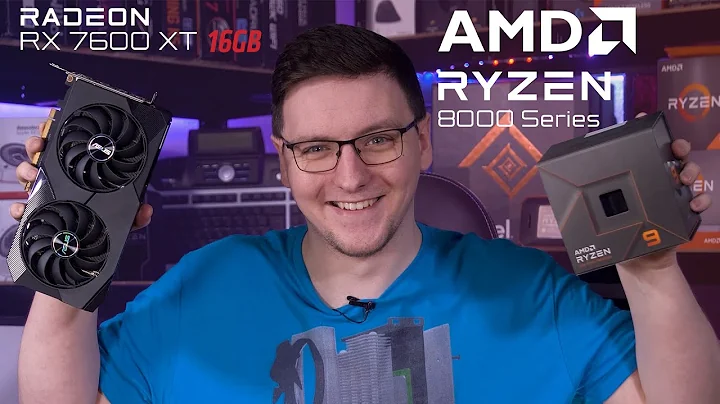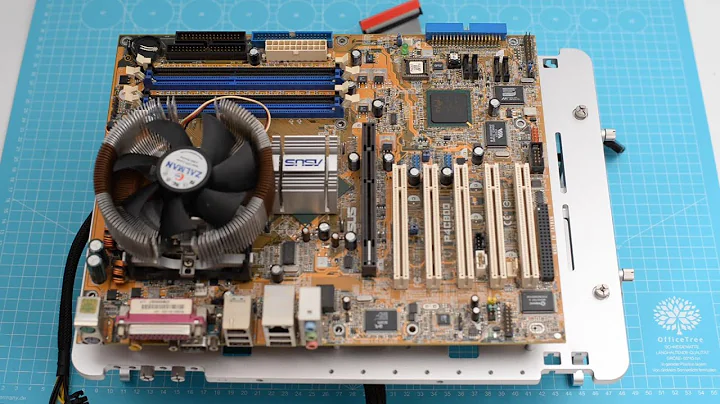RDNA 2 Refresh: Boosting AMD's Performance and Intel ARC Leak
Table of Contents
- Introduction
- RDNA 2 Refresh: Overview
- Memory Speeds of RDNA 2 Refresh
- AMD's Product Launches
- The Anticipated 6950XT Graphics Card
- The Delayed Launch of the 3090 TI
- The Potential Paper Launch of EVGA Kingpin 3090 TI
- The Lack of Volume for Intel's Alchemist
- The Competitive Advantage of AMD's 6950XT
- Speculations on the 6750XT Graphics Card
- The Importance of Clock Speeds in RDNA 2
- Implications for the Market and Pricing of Alchemist
- The Uncertainty of Alchemist's Launch Date
- Conclusion
RDNA 2 Refresh: Boosting AMD's Graphics Performance
🔍
The graphics card industry has been rife with anticipation regarding AMD's RDNA 2 refresh. Set to be built on a seven nanometer architecture, this refresh promises significant performance upgrades and improved memory speeds. In this article, we will delve deeper into the details surrounding the RDNA 2 refresh, including the anticipated product launches and their potential impact on the market. So, let's dive in and explore the exciting new developments in the world of graphics cards.
Memory Speeds of RDNA 2 Refresh
💡
One of the key highlights of the RDNA 2 refresh is the memory speed. Industry insiders suggest that the new graphics cards will use memory with speeds of at least 18 gigabits per Second. This marks a significant leap in memory performance when compared to previous models. While some may argue that higher speeds are possible, 18 gigabits per second is believed to be the new standard for memory speeds. It is important to note that future iterations, such as RDNA 3, might see memory speeds reaching up to 27 gigabits per second. The excitement surrounding this increase in memory speed bodes well for the impending launch of these graphics cards.
AMD's Product Launches
💥
AMD is gearing up to launch a lineup of graphics cards that take full advantage of the RDNA 2 refresh. While the exact details of the product launches are still being finalized, one card that is definitely on the horizon is the highly anticipated 6950XT. This card is being developed to directly compete with Nvidia's 3090 TI, providing a viable alternative for consumers looking for top-tier performance. With the potential of surpassing the 3090 TI in certain games and resolutions, the 6950XT has generated a great deal of excitement within the gaming community.
The Delayed Launch of the 3090 TI
⚠️
In a surprising turn of events, Nvidia has encountered difficulties in launching the 3090 TI. These challenges stem from issues with yields and the need for higher voltage, resulting in problems with memory. The prospect of a complete redesign of the PCB may further delay the launch. However, industry insiders speculate that there may be a peculiar pseudo paper launch of certain high-end models, such as the EVGA Kingpin 3090 TI. These models, known for their exceptional engineering, can likely handle the required voltage without the need for a PCB redesign. While this may lead to some limited availability in April, the bulk of the 3090 TI launch is expected to be postponed, thus providing an opportune opening for AMD's 6950XT.
The Lack of Volume for Intel's Alchemist
📉
On the other HAND, Intel's Alchemist graphics card seems to be facing significant challenges in terms of volume production. Reports indicate that the card's launch has been delayed to quarter two, with major products targeting April or later. While there may be some paper launches and low-end offerings for laptops in April, the high-end desktop versions are not expected until June. This delay poses a significant setback for Intel in terms of market positioning and opens up immense opportunities for AMD's 6950XT, which is primed to match or even surpass the performance of Nvidia's delayed 3090 TI.
The Competitive Advantage of AMD's 6950XT
💪
The impending launch of AMD's 6950XT holds immense promise for gamers and graphics enthusiasts. This graphics card, designed to rival the performance of Nvidia's 3090 TI, aims to deliver a compelling combination of power and affordability. With the advantage of being built on a more mature node, the 6950XT can potentially outperform its predecessor, the 6800, while maintaining competitive pricing. Moreover, by leveraging the smaller die size of the RDNA 2 architecture, AMD may even surpass the performance of Intel's Alchemist card, if not in raw power, then certainly in terms of pricing and availability.
Speculations on the 6750XT Graphics Card
❓
While AMD's focus is primarily on the 6950XT and other high-end offerings, rumors suggest the possibility of another graphics card, namely the 6750XT. This card, if launched, could bring a slew of advantages to AMD. Given that minimal navi 21 yields would need to be disabled to achieve the RX 6800 specifications, AMD could redirect these intact chips to create a highly competitive card. With performance on par with Nvidia's 3070 and a smaller die size, the 6750XT has the potential to disrupt the market with its pricing and availability, giving Intel's Alchemist a run for its money.
The Importance of Clock Speeds in RDNA 2
⏰
As AMD fine-tunes its RDNA 2 refresh, clock speeds emerge as a key consideration. By maximizing the clock speeds of the Navi 22 architecture, AMD can potentially narrow the performance gap between the 6750XT and the 6800, all while bolstering production volume. This strategic move allows AMD to cater to a broader market segment by offering a graphics card that competes directly with Intel's Alchemist in terms of both performance and pricing. In a rapidly evolving landscape, clock speeds become an integral factor that determines success in the pursuit of the ultimate graphics card.
Implications for the Market and Pricing of Alchemist
💰
With Alchemist's launch being pushed to quarter two, Intel must carefully navigate the landscape of pricing and demand. The delays in Alchemist's release provide an opportunity for AMD's 6950XT to establish a strong foothold in the market. Intel, with its ambitious foray into the discrete graphics card market, needs to price its Alchemist cards competitively to counter AMD's offerings effectively. Moreover, Intel must be mindful of the impending launch of AMD's RDNA 3 architecture, which promises even greater performance gains. Success for Alchemist hinges on Intel's ability to strike the right balance between aggressive pricing and captivating performance.
The Uncertainty of Alchemist's Launch Date
❗
Despite the multitude of rumors and leaks, the concrete launch date for Intel's Alchemist graphics card remains elusive. Conflicting information from various sources within the industry indicates a wide timeframe for the release of Alchemist. While some sources suggest April as a possible launch window, others point to a later date in June. The disparity in these timelines adds to the confusion surrounding Alchemist's arrival. However, one thing is clear: Alchemist's launch in quarter one is highly unlikely. As consumers eagerly await Intel's entry into the graphics card market, they must exercise patience, as the launch of Alchemist will likely occur in quarter two or beyond.
Conclusion
🎯
In conclusion, the RDNA 2 refresh holds immense potential for boosting AMD's graphics performance and challenging incumbents like Nvidia and Intel. The upcoming launch of AMD's 6950XT, alongside potential releases like the 6750XT, presents an intriguing landscape for consumers seeking high-performance graphics cards. As the industry eagerly anticipates the launch of Intel's Alchemist, delays in release and production volume create opportunities for AMD to solidify its position in the market. It remains to be seen how Intel will navigate these challenges and position Alchemist competitively. The battle for dominance in the graphics card market is set to intensify, and consumers can expect exciting developments and fierce competition in the months to come.
Highlights
💡
- AMD's RDNA 2 refresh promises improved graphics performance and higher memory speeds.
- The 6950XT, a highly anticipated graphics card, aims to rival Nvidia's 3090 TI.
- Nvidia's 3090 TI faces delays due to issues with yields and memory voltage.
- Intel's Alchemist graphics card launch is pushed to quarter two, creating an opportunity for AMD.
- The 6750XT, if launched, could disrupt the market with competitive pricing and performance.
- AMD's focus on clock speeds enables greater production volume and challenges Intel's Alchemist.
- Pricing and market positioning will be crucial for Intel's success with Alchemist.
- The launch date of Alchemist remains uncertain, with conflicting information from various sources.
- The battle for dominance in the graphics card market intensifies as RDNA 2 and Alchemist approach.
FAQ
❓
Q: Will the RDNA 2 refresh graphics cards be compatible with existing systems?
A: Yes, the RDNA 2 refresh will be backward compatible with existing systems, ensuring that users can seamlessly upgrade their graphics cards without the need for additional hardware changes.
Q: What can we expect from the pricing of the 6950XT compared to Nvidia's 3090 TI?
A: While exact pricing details are yet to be confirmed, AMD has been known to offer competitive pricing in the past. It is likely that the 6950XT will be priced attractively to entice consumers and establish a strong foothold in the market.
Q: Are there any performance benchmarks available for the 6750XT?
A: As of now, performance benchmarks for the 6750XT are not available. However, based on speculation and the potential use of intact Navi 21 yields, the 6750XT has the potential to deliver performance that rivals Nvidia's 3070.
Q: How will the delayed launch of Intel's Alchemist impact the market?
A: The delay in Alchemist's launch provides an opportunity for AMD's 6950XT to gain traction in the market and capture consumers who are eagerly awaiting high-performance graphics cards. Intel will need to carefully position Alchemist with competitive pricing and performance to counter AMD's offerings effectively.
Q: When can we expect the launch of Alchemist?
A: The exact launch date for Alchemist remains uncertain. Conflicting information suggests a launch window between April and June, with the latter being more likely. Consumers should exercise patience and stay tuned for official announcements from Intel.
Q: How will AMD's RDNA 2 refresh affect future graphics card releases?
A: The RDNA 2 refresh sets the stage for future graphics card releases, such as RDNA 3. It establishes a benchmark for improved memory speeds and performance, raising the bar for subsequent iterations. As the industry evolves, graphics card manufacturers will need to continually innovate to stay competitive.
 WHY YOU SHOULD CHOOSE TOOLIFY
WHY YOU SHOULD CHOOSE TOOLIFY



































